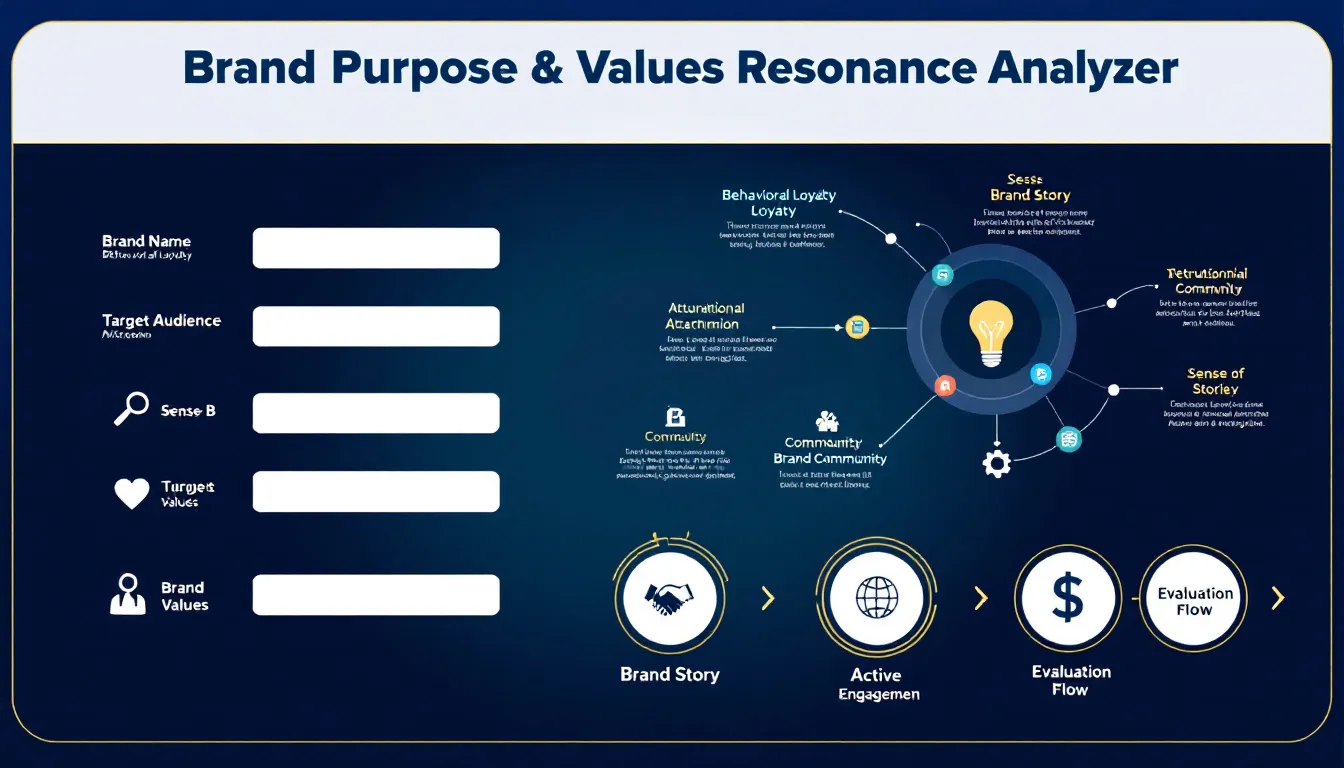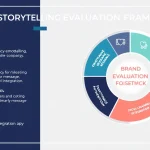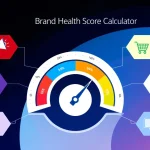Is this tool helpful?
How to Use the Brand Purpose & Values Resonance Analyzer Effectively
1. Brand Name Input
Enter the full name of the brand you want to evaluate. This helps the tool contextualize the analysis based on the brand’s identity.
- Example 1: “Blue Apron” – A meal kit delivery service focused on convenience and fresh ingredients
- Example 2: “Everlane” – A fashion brand known for transparent sourcing and ethical manufacturing
2. Target Audience Description
Describe your target audience with as many relevant details as possible. This helps evaluate how well your brand resonates with those specific groups.
- Age groups and demographic data
- Consumer interests and lifestyle traits
- Behavioral patterns and buying habits
Try detailed examples like:
- Example 1: “Young parents ages 25-35 who seek healthy, organic food options and value convenience in meal preparation”
- Example 2: “Tech-savvy entrepreneurs aged 30-50 interested in sustainability and innovative products with social impact”
3. Brand Purpose and Mission
Explain your brand’s core mission clearly. Highlight your business objectives, social impact, market positioning, and what sets you apart.
- Why your brand exists
- Goals related to customers and society
- How you stand out in the market
4. Core Brand Values
List the fundamental values your brand stands for. These are the guiding principles that shape operations and customer interactions.
- Ethical and environmental commitments
- Transparency and authenticity
- Innovation and quality standards
5. Brand Story and History
Share your brand’s journey to help the tool assess emotional connection. Include key moments that shaped your growth and identity.
- How your brand started
- Major milestones and achievements
- Evolution of your brand’s purpose and offerings
What the Brand Purpose & Values Resonance Analyzer Does
This tool helps you understand the emotional and psychological bond between your brand and its audience. By analyzing your brand’s purpose, values, target market, and story, it evaluates how effectively your brand connects on a deeper level. This analysis goes beyond surface-level marketing, helping you align your messaging with what truly resonates with customers.
- Measure behavioral loyalty: Gauge how likely your audience is to stick with your brand based on emotional ties.
- Assess attitudinal attachment: Understand the strength of your brand’s influence on customer attitudes.
- Determine sense of community: See how well your brand fosters connection and belonging among your audience.
- Evaluate active engagement: Analyze level of interaction and enthusiasm your brand generates.
Practical Uses for Your Brand
Use this analyzer to make informed decisions about your branding strategy. It supports a variety of goals and helps you:
1. Refine Brand Positioning
- Identify gaps between your brand’s stated purpose and audience perception
- Adjust messaging to enhance clarity and emotional appeal
2. Develop Targeted Marketing Strategies
- Create campaigns that reflect your core values and resonate with specific audience segments
- Focus on themes that foster customer loyalty and engagement
3. Strengthen Customer Relationships
- Build trust through consistent brand storytelling and authenticity
- Increase customer lifetime value by deepening emotional connections
Addressing Common Brand Resonance Challenges
Authenticity Verification
- Spot inconsistencies between your brand’s messages and real-world actions
- Ensure your brand purpose is credible and reflected in customer experiences
Brand Differentiation Assessment
- Highlight what uniquely sets you apart from competitors
- Analyze how sustainable your advantages are in your market
Evaluating Emotional Connection
- Measure how your brand story and values inspire loyalty and trust
- Identify ways to strengthen relationships with your audience
Real-World Application Examples
Case Study: Sustainable Fashion Brand
A sustainable apparel company used this tool to analyze audience alignment and brand story impact:
- Discovered gaps between claimed ethical practices and customer perception
- Implemented recommended storytelling adjustments that increased engagement by 30%
- Improved trust and loyalty, leading to a 20% rise in repeat purchases within six months
Case Study: Health Tech Startup
A health technology company applied the analyzer to connect more deeply with healthcare professionals:
- Recognized disconnect between brand messaging and user expectations
- Refined mission focus and values communication, boosting brand perception scores by 25%
- Enhanced customer engagement, resulting in increased adoption rates
Frequently Asked Questions about Brand Resonance Evaluation
What defines an authentic brand purpose?
An authentic brand purpose aligns your business actions with your stated mission. It consistently reflects your values through every touchpoint and makes a real difference in areas that matter to your audience.
How often should I evaluate brand resonance?
Evaluate brand resonance regularly. For dynamic industries, do this quarterly. Established brands should assess semi-annually. Also consider evaluations after major changes, product launches, or market shifts.
Can brand resonance improve over time?
Yes. Consistent delivery on your values, clear communication, and meaningful engagement steadily increase brand resonance and customer loyalty.
Why is emotional connection important for brand success?
Emotional bonds inspire loyalty, increase buying frequency, encourage advocacy, and build resilient relationships that sustain your brand through competition and market changes.
How does brand story influence resonance?
Your brand story builds emotional connections and trust. It makes your mission relatable and strengthens how customers identify with your purpose.
How do I keep my brand authentic as it grows?
Stay true to your core values, communicate transparently, engage genuinely with your audience, and align your actions with your stated purpose throughout growth phases.
Advanced Considerations for Brand Resonance
Aligning Brand Resonance with Business Strategy
Strong brand resonance supports your corporate goals, growth plans, customer experience, and product development. Make sure your brand purpose and values integrate seamlessly with broader business strategies.
Considering Cultural Relevance
Track societal trends, cultural movements, and global or local shifts impacting your audience. Reflect these insights in your brand’s resonance efforts to stay relevant and meaningful.
Leveraging Digital Channels for Brand Resonance
Maximize social media, digital engagement, and online communities to deepen emotional connections. Use virtual experiences to reinforce your brand’s story and values effectively across channels.
Important Disclaimer
The calculations, results, and content provided by our tools are not guaranteed to be accurate, complete, or reliable. Users are responsible for verifying and interpreting the results. Our content and tools may contain errors, biases, or inconsistencies. Do not enter personal data, sensitive information, or personally identifiable information in our web forms or tools. Such data entry violates our terms of service and may result in unauthorized disclosure to third parties. We reserve the right to save inputs and outputs from our tools for the purposes of error debugging, bias identification, and performance improvement. External companies providing AI models used in our tools may also save and process data in accordance with their own policies. By using our tools, you consent to this data collection and processing. We reserve the right to limit the usage of our tools based on current usability factors.







